NSKK Shirt
CATEGORY: Version
SKU: 53.GOR.02.01.04.001.000
Estimated market value:
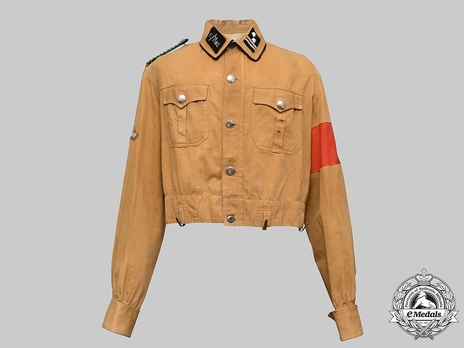
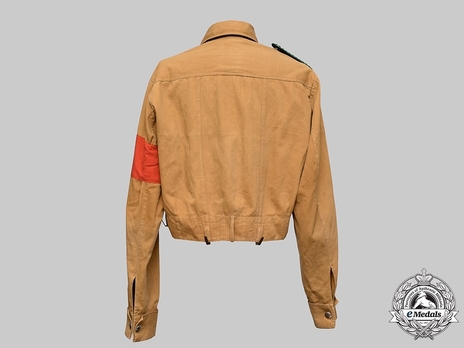
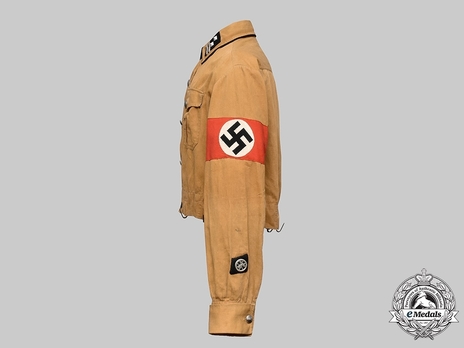
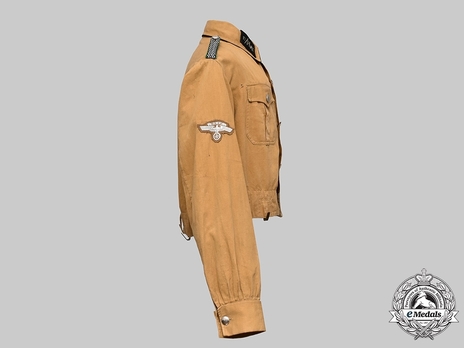
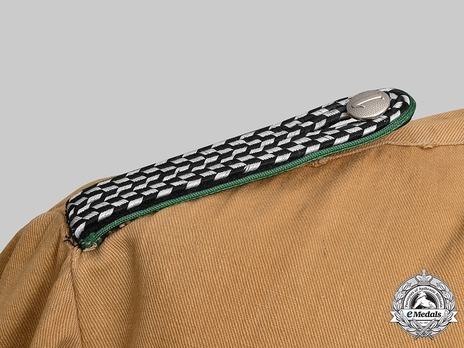
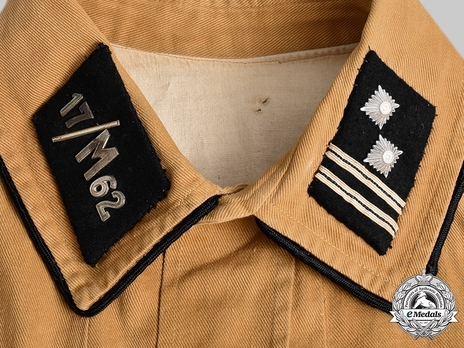
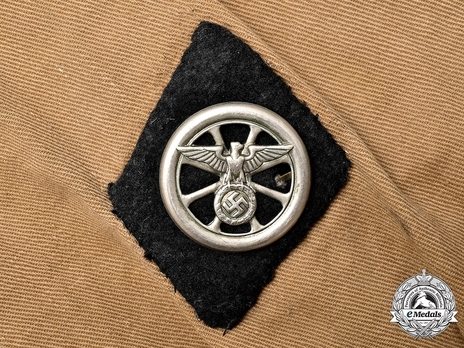
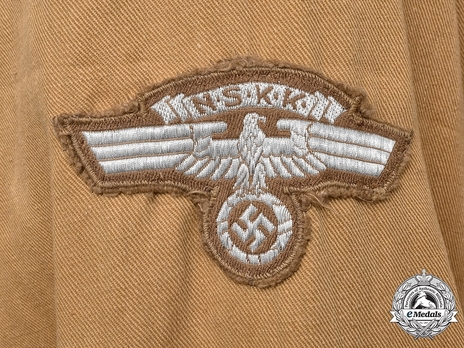
Estimated market value:
This is an extremely well-preserved National Socialist Motor Corps (Nationalsozialistisches Kraftfahrkorps) brownshirt, constructed of a light-brown cotton twill. The collar is neatly trimmed from end-to-end with woven black piping, and bears dual tabs, each measuring 40 mm (w) x 60 mm (l). The right tab is constructed of black wool and bears the unit insignia of Motorsturm “17” of Motorstandarte “62”. The right tab, of identical construction and dimensions, bears two silvered bronze rank pips and two bands of white machine embroidery with central black bands, indicating a rank of Haupttruppführer. The right shoulder is adorned with a board, constructed of black wool and trimmed with green piping, topped by four bands of interwoven black and silver threading. Measuring 22 mm (w) x 125 mm (l), the board is secured to the tunic by stitching at the outer edge, and by a pebbled, silvered magnetic metal button bearing a raised number “1” on the interior. Stitched onto the upper left arm is an insignia, constructed of brown rayon, bearing a silver, machine-embroidered, flat wire NSKK-style German national eagle clutching a wreathed mobile swastika, topped by the organization’s acronym, measuring 90 mm (h) x 55 mm (h). Stitched onto the upper right arm is a NSDAP-style armband, constructed of red cotton, with a central, machine-embroidered black mobile swastika on a white disk. The cuff of the same arm bears a first-pattern NSKK driver’s diamond, constructed of a black wool patch measuring 50 mm (w) x 64 mm (h), into which is pinned a magnetic metal wheel bearing a NSKK-style German national eagle clutching a wreathed mobile swastika, measuring 30 mm in diameter.
Each breast of the shirt bears a single pocket, opening with a horizontal slit and stylized flap bearing a reinforced buttonhole, in turn meeting a silvered magnetic metal button. The left pocket has two vertically-arranged black thread loops accommodating a decoration with a vertical pinback. The breast flaps are closed by three magnetic metal buttons and two brown bakelite buttons on the right meeting an equal number of reinforced buttonholes on the left. Set into the shirt at the bottom are five magnetic metal belt hooks. The interior of the shirt is plain and unmarked. It measures approximately 438 mm across the shoulder, with an arm length of 646 and an overall body length of 530 mm. Slight soiling and fatigue is evident, but the shirt is in an otherwise near extremely fine condition.
The NSKK (Nationalsozialistisches Kraftfahr-Korps = National Socialist Motor Corps) was a paramilitary organisation affiliated with the NSDAP, specialising in anything related to the driving of motorised vehicles. NSDAP officials recognised the need for access to cars and trucks for both transportation and propaganda purposes as early as 1922, and certain steps were taken to ensure this need was met. However, it took until April of 1930 for a specialised motor organisation to be officially founded. This organisation was named NSAK (Nationalsozialistisches Automobil-Korps = National Socialist Automobile Corps), but was renamed to NSKK less than 13 months later.
Initially, the NSAK/NSKK was under the control of the SA and existed next to its parent organisation’s own driving-related sub-organisation, the Motor-SA. This changed after the “Night of the Long Knives”, in which many SA leaders were purged and the organisation was substantially disempowered. After July of 1934, the NSKK became an independent organisation whose leader, NSKK-Korpsführer Adolf Hühnlein, answered directly to Adolf Hitler.
The main tasks of the NSKK were to provide transportation for all organisations of the Third Reich, to train and instruct boys and men (and a number of women) in mechanics and driving, and to assist police in regulating traffic. During the mid 1930s, the organisation also provided roadside assistance.
With the onset of the war, the NSKK’s tasks underwent certain changes. Instructing both civilians and soldiers in the driving and maintenance of armored vehicles became a higher priority. The NSKK also began working closely with other organisations, for example Organisation Todt (OT), by providing transportation of workers and supplies for the colossal building project that was the fortification of Germany’s Western border, the Siegfried Line (or Westwall). During the war, the NSKK provided much of the transportation needs for the German Army and the Luftwaffe, including the transport of troops, weapons and ammunition, and building materials, for example for the construction of air bases in the newly conquered territories in Eastern Europe after the attack on Soviet Russia in the summer of 1941.
Parts of the NSKK would come under the control of architect Albert Speer who took over OT after the death of Fritz Todt in 1942, leading to the creation of Transport Brigade Speer (later Transport Corps Speer), which would eventually completely sever its ties to the NSKK.
The members of the NSKK were issued a brown shirt with a short waist that was to be worn on festive occasions. The shirt has two pleated breast pockets with buttoned flaps and five buttons down the front. The buttons down the front of the shirt, on the breast pockets, and securing the cuffs are matte silver with a pebbled finish. There are brown horn buttons at the neck and waist of the shirt. The front waistline of the shirt has sewn-in belt ramps and the reverse waistline features cloth belt loops.
Individuals with the rank of Sturmmann to Haupttruppführer wore shirts that had black cord piping on the collar, while Officers, ranks Sturmführer and above, wore shirts with aluminium piping around the collar.
The shirt was worn with collar tabs, a driver's badge, and a shoulder tab. A brown or white longsleeve blouse was worn under the shirt.

Comments
Sign in to comment and reply.


Scroll Top